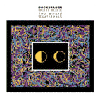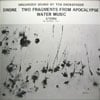Compositions » Water Music
Water Music began with the sound of water; there is little else in the piece. I’ve described organized sound as the technique using everything and the kitchen sink; this is the piece that uses the sink - a kind of kitchen La Mer. I suspected these sound sources were capable of complex organization - in short, of making a kind of music. And yet the processes of mechanical and electronic abstraction they went through during organization did not rob them of their essential quality: a sometimes delicate, sometimes ponderous, wetness.
There are six short parts, each one of varying degrees of density, acceleration, loudness. Some are lyrical, some violent - both, I feel, are qualities of water. The parts do not form movements - the movement is within each part. The whole work is an exploration of one sound, the nature of which lent itself to a kind of counterpoint. To augment the initial sound sources, I’ve added other similar sounds.
Water Music had its premiere on WXQR in June 1963. At the end of the broadcast, the announcer stated that, since electronic music wasn’t going anywhere, the broadcast would be the last of its kind. They’d also played Stockhausen’s Gesang der Jünglinge - so I went out in good company.
Water, toy gong-rattles, Indian finger bells, sheet of metal, two test generators (rewired for instability), two water glasses, a Coke bottle, a metal garbage can (to hold the water), a nail.
Water Music - part 3
Releases

Quatermass (STARKLAND, 1992)
ST-201
Water Music, Quatermass, and Two Moons of Quatermass.

Organised Sound by Tod Dockstader (Doxy Records, 2014-06-02)
DOZ426
Drone, Water Music, Two Fragments from Apocalypse.

Organised Sound by Tod Dockstader (OWL Records, 1966)
ORLP-7
Drone, Water Music, Two Fragments from Apocalypse.